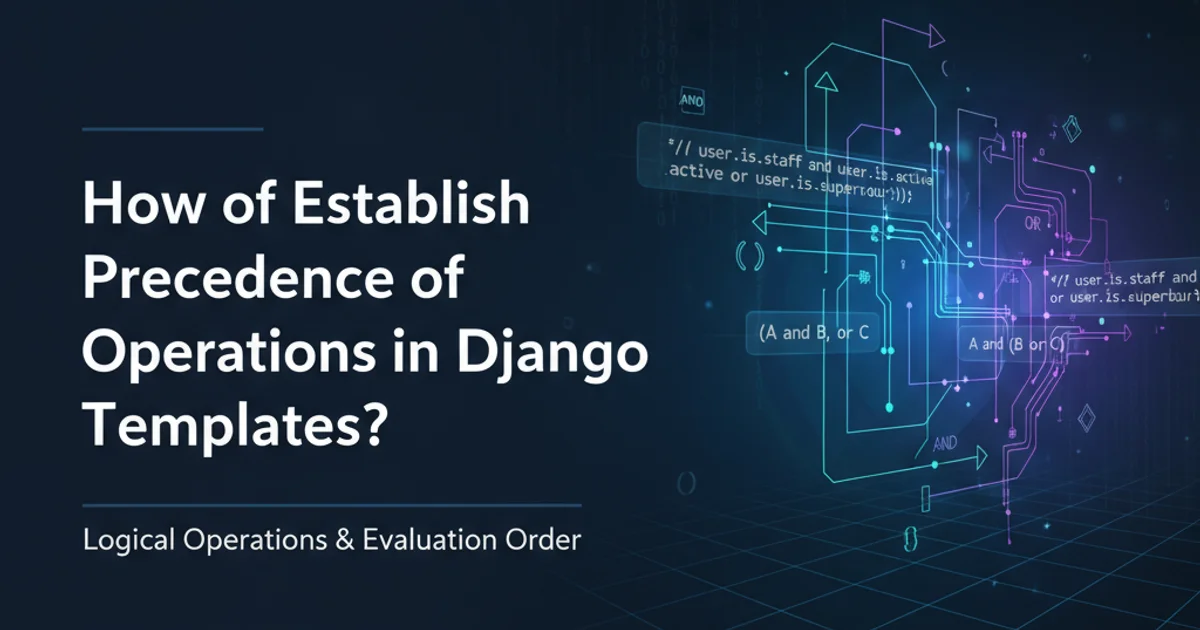How establish precedence of operations in Django Templates?
Categories:
Mastering Precedence in Django Template Operations

Understand how Django templates evaluate expressions and establish the order of operations to write predictable and effective template logic.
Django's template language is designed to be simple and secure, intentionally limiting its power compared to full-fledged programming languages. This simplicity means that while you can perform basic operations and comparisons, the concept of 'operator precedence' as found in Python or JavaScript is handled somewhat differently and less explicitly. Understanding how Django templates evaluate expressions is crucial for avoiding unexpected behavior and writing robust template code.
Basic Evaluation in Django Templates
Django templates primarily evaluate expressions from left to right. There isn't a complex hierarchy of operators like multiplication before addition. Instead, operations are often chained using filters, and comparisons are typically evaluated as standalone units. The most common 'operations' you'll encounter are variable lookups, filter applications, and simple comparisons within {% if %} tags.
{% if user.is_authenticated and user.has_premium_access %}
Welcome, premium user!
{% endif %}
{{ product.price|add:10|floatformat:2 }}
{% if item.quantity > 0 or item.is_available %}
Item is ready.
{% endif %}
Examples of logical and filter operations in Django templates.
Understanding Filter Chaining and Order
Filters are applied sequentially from left to right. Each filter takes the output of the previous filter (or the initial variable value) as its input. This is the most explicit form of 'precedence' you'll find in Django templates. For example, {{ value|filter1|filter2 }} means filter1 is applied to value, and then filter2 is applied to the result of filter1.
{{ my_string|lower|capfirst }}
{# Equivalent to: capfirst(lower(my_string)) #}
{{ my_number|add:5|multiply:2 }}
{# Equivalent to: (my_number + 5) * 2 #}
Filter chaining demonstrates left-to-right evaluation.
flowchart LR
A[Initial Value] --> B[Filter 1]
B --> C[Filter 2]
C --> D[Final Output]Visual representation of filter chaining and evaluation order.
Logical Operators in {% if %} Tags
Inside {% if %} tags, Django supports and, or, and not operators. These operators follow standard boolean logic. not has the highest precedence, followed by and, and then or. However, parentheses are not supported to explicitly group expressions, which can sometimes lead to ambiguity if not carefully managed. It's best to keep if conditions simple or break them into nested if statements if complexity arises.
{% if not user.is_staff or user.is_superuser %}
{# Evaluates as (not user.is_staff) or user.is_superuser #}
Access granted to non-staff or superusers.
{% endif %}
{% if user.is_active and user.profile.is_verified or user.is_admin %}
{# Evaluates as (user.is_active and user.profile.is_verified) or user.is_admin #}
User is active and verified, or is an admin.
{% endif %}
Precedence of logical operators in {% if %} tags.
() for grouping expressions within {% if %} tags. If you need complex logical grouping, it's highly recommended to perform the logic in your Python view and pass a pre-evaluated boolean result to the template.Best Practices for Clarity and Predictability
Given the limited explicit precedence rules in Django templates, the best approach is to prioritize clarity and simplicity. Avoid overly complex expressions directly in the template. When in doubt, move complex logic to your views or custom template tags/filters.
1. Keep {% if %} conditions simple
Limit {% if %} conditions to one or two logical operators. For more complex logic, pre-process the data in your view.
2. Chain filters explicitly
Understand that filters apply from left to right. Plan your filter order to achieve the desired transformation.
3. Use custom template tags/filters for complex logic
If you find yourself needing advanced operations or specific precedence, create a custom template tag or filter to encapsulate that logic in Python.
4. Test your template logic
Always test template expressions with various data inputs to ensure they behave as expected, especially when dealing with multiple filters or logical conditions.